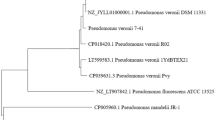Abstract
TOLUENE, like many organic sovents, is highly biotoxic and kills most microorganisms at low concentrations (0.1% v/v). It is often used therefore to sterilize microbial cultures and lyse bacterial cells in the assay of bacterial enzymes1–3. The physiological basis of such solvent toxicity, however, remains poorly characterized. Although some microorganisms, including Pseudomonas4–6 , Achromobacter4 and Nocardia7 , can assimilate toluene, their toler-ance for the solvent is less than 0.3% (v/v). We report here the discovery of a variant strain of Pseudomonas putida which is capable of growing in media culture containing more than 50% (v/v) toluene or high concentrations of cyclohexane, xylene, styrene and heptanol. By studying this unusually tolerant strain we show that the relative toxicities of different solvents are determined by their polarities.
This is a preview of subscription content, access via your institution
Access options
Subscribe to this journal
Receive 51 print issues and online access
$199.00 per year
only $3.90 per issue
Buy this article
- Purchase on Springer Link
- Instant access to full article PDF
Prices may be subject to local taxes which are calculated during checkout
Similar content being viewed by others
References
Herzenberg, L. A. Biochim. biophys. Acta. 31, 525–539 (1959).
Dobrogosz, W. J. & DeMoss, R. D. J. Bact. 85, 1350–1365 (1963).
Leventhal, C., Singer, E. R. & Fetherhor, K. Proc. natn. Acad. Sci. U.S.A. 48, 1230–1238 (1962).
Worsey, M. J. & Williams, P. A. J. Bact. 124, 7–13 (1975).
Kitagawa, M. J. Biochem., Tokyo 43, 553–563 (1956).
Claus, D. & Walker, N. J. gen. Microbiol. 36, 107–122 (1964).
Raymond, R. L., Jamison, V. W. & Hudson, J. O. Appl. Microbiol. 15, 857–865 (1967).
Bergey Manual of Systematic Bacteriology (Williams & Wilkins, 1984).
Corwin, H. & Anderson, M. J. org. Chem. 32, 2583–2586 (1967).
Rekker, R. F. & de Kort, H. M. Eur. J. med Chem. chim. Therapeut. 14, 479–488 (1979).
Harnisch, M. Mockel, H. J. & Schulze, G. J. Chromatogr. 282, 315–332 (1983).
Author information
Authors and Affiliations
Rights and permissions
About this article
Cite this article
Inoue, A., Horikoshi, K. A Pseudomonas thrives in high concentrations of toluene. Nature 338, 264–266 (1989). https://doi.org/10.1038/338264a0
Received:
Accepted:
Issue Date:
DOI: https://doi.org/10.1038/338264a0
This article is cited by
-
Genome analysis of a coral-associated bacterial consortium highlights complementary hydrocarbon degradation ability and other beneficial mechanisms for the host
Scientific Reports (2023)
-
Involvement of catalase and superoxide dismutase in hydrophobic organic solvent tolerance of Escherichia coli
AMB Express (2021)
-
Application and characterization of crude fungal lipases used to degrade fat and oil wastes
Scientific Reports (2021)
-
Volatile 1-octanol of tea (Camellia sinensis L.) fuels cell division and indole-3-acetic acid production in phylloplane isolate Pseudomonas sp. NEEL19
Scientific Reports (2021)
-
Production of itaconic acid from alkali pretreated lignin by dynamic two stage bioconversion
Nature Communications (2021)
Comments
By submitting a comment you agree to abide by our Terms and Community Guidelines. If you find something abusive or that does not comply with our terms or guidelines please flag it as inappropriate.



